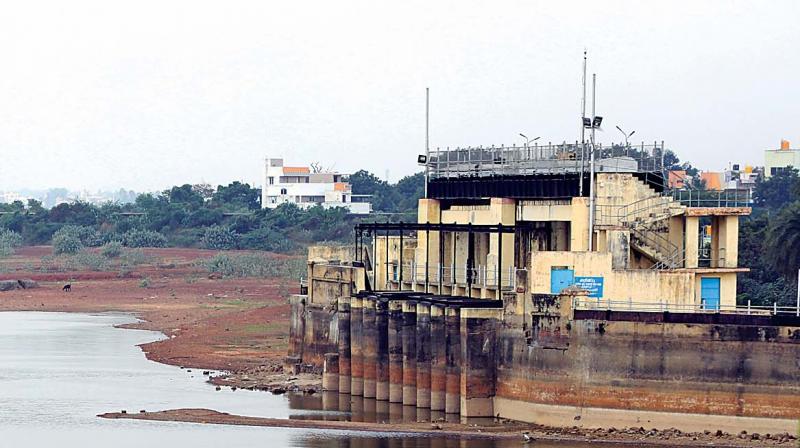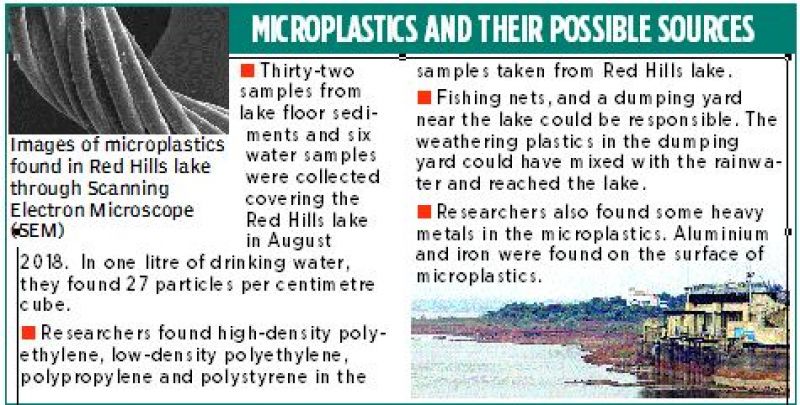Microplastics in drinking water pose huge threat to Chennai
The source for Polystyrene could be the thermocol being dumped near the lake.

Chennai: Microplastics, a hitherto unheard of health hazard, has been detected in abundant quantity in Red Hills lake (popularly known as Puzhal Eri), which is one of the main drinking water sources for Chennai.
But what really should send a shiver down the spine of anyone consuming the water supplied by Metrowater to Chennai homes is the fact that microplastics turn more deadly when the water is heated; at 100 degrees Celsius, a toxic substance called ‘dioxin’ (a carcinogen) is released that dissolves in the water.
The saving grace, however, is that the researchers involved in the first-ever comprehensive scientific study of microplastics contamination in freshwater systems have also developed a bio-degradable filter for end users of the water.
As of now, the Chennai Metro Water Supply and Sewerage Board does not have any filtering mechanism for microplastics. The water board only treats water with chlorine to kill germs and disinfect it. For microplastics, they have no clue like most of us.
The team of researchers from Anna University took samples from the lake in August last year. “We have collected 32 samples from the lake’s floor sediments and six water samples covering the full lake. The uppermost part of the lake has microplastics in range of 1 micrometre to 2 micrometres,” said G Kalpana, a scientist at the Institute for Ocean Management in Anna University.
The analysis of microplastic in water and sediment was done as per the National Oceanic and Atmospheric Administration (NOAA) protocol. In one litre of drinking water, they found 27 particles per centimetre cube.
“The most commonly found microplastics are fibres (37.9%), fragments (27%), films (24%), and pellets (11.1%). Based on the FTIR (Fourier-Transform Infrared Spectroscopy), the microplastics were identified as high-density Polyethylene, low-density Polyethylene, Polypropylene and Polystyrene,” she said.
The source for Polystyrene could be the thermocol being dumped near the lake. Fishing nets could be one of the sources for Polyethelene (high-density fibres).
“The stormwater and airborne particles (less than 20-micrometre particles can be transmitted through the wind) also could be the main reasons for microplastics in drinking water,” another researcher, S.Krishnakumar, explained.
Further samples were evaluated for surface elemental composition in order to understand whether heavy metals get adhered to the surface of microplastics, using Energy Dispersive X-Ray method.

Researchers found heavy metals such as aluminium and iron with microplastics. Generally, microplastics will enter the body as a foreign particle if we drink normal water. Due to increased health consciousness, people boil drinking water. But when we boil water contaminated by microplastics, it could release carcinogenic material like dioxin.
“When you boil the water, microplastics melt at 100 degrees Celsius and it releases dioxin which dissolves in water. It could pose a major health threat to people who consume the water with microplastics,” says Professor S.Srinivasalu, director, Institute for Ocean Management, Anna University.
“Plastics have changed from contaminant to pollutant and turned into toxicants. If we don’t take proper measures, it is going to be a very big problem,” he warned.
Instead of highlighting only the problem, the researchers have formed a larger team including researchers from other streams such as
nano-technology and textile technology to come up with a solution. They are also studying the possible health impact of microplastics.
N Gopi, associate professor in the Department of Textile Technology, and T Devasena from the Centre for Nano-Science and Technology, are working towards a technology solution for removal of microplastics from drinking water.
Based on the lab experiments, the researchers at Anna University have developed filters to absorb microplastics along with some toxicants and pollutants.
“We have to use a bio-degradable filter at the end to make sure that microplastics are removed from the drinking water. As of now, there is no awareness about microplastics contamination in freshwater systems,” Professor Srinivasalu said.
The researchers are planning to study all the four reservoirs that supply water to the city. This research will soon to be published in the journal Environmental Toxicology and Chemistry.

